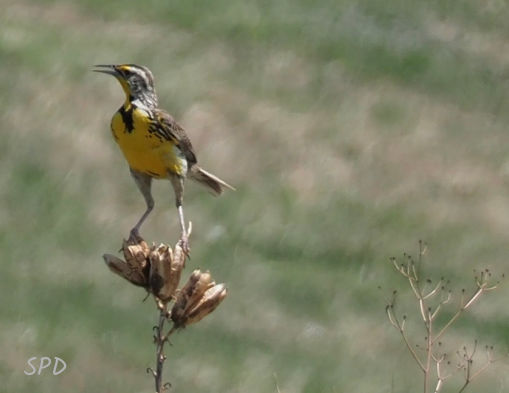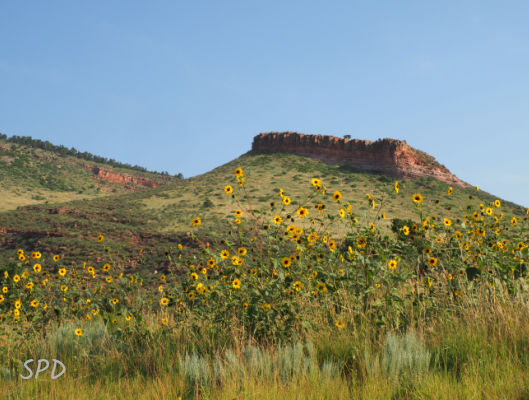A multitude of insects will be feeding on this native plant, Yucca glauca, in spring, just in time for the Western Meadowlark to feed them to its nest of chicks. The majority of songbird babies must have a high-protein, easily eaten, and digestible diet of insects.
The UN Decade of Restoration is now in its second year. Are you helping? It’s a big goal – preventing, halting, and reversing the degradation of ecosystems. We all want that. But what? You’re not a restoration ecologist? Me neither. But there are plenty of things any individual citizen can do; here is a story of one of the things I did, and a list of some options you might like to think about as we collectively move toward restoration in this decade.
Picture a snow-covered hilly patch of shrubs near a pond. I am slogging through the white stuff watching for birds and ducks. Ahead of me, most improbably to my mind, a man is pushing his bicycle along the track.
When he stops and sets up a spotting scope, I have him clearly pegged as a birder. He has set the scope on a Northern Shrike and generously offers me a peek, along with some tips on how to identify the species, and also likely places to see them in the area.
We both enjoy the view of the bird and then begin to share some of the other observations we have each made that morning. In the course of the conversation, I admit that my specialty is not birds but native plants. “Oh,” he says, “do you know what this one is?,” pointing to a small tree next to us.
“Yes,” I reply, “it’s a Russian olive, not native unfortunately”
“Oh, but birds really like it!”
I pause. But because we have been having a mutually respectful conversation, I plunge ahead and explain that even though some birds like it, the Russian olive (Elaeagnus angustifolia) is not a card-carrying member of the local food web. A highly adaptive species, it spreads rapidly, chokes water flow, blocks sunlight from important meadows and forest edges, and displaces the native plant communites. Those native communties support far higher densities of species, and species richness, especially of breeding birds. Almost half the threated and endangered species in the US are imperiled by alien species like this one.
“Ouch,” is the sad reply.
Specialized relationships between plants and insects are the norm, not the exception. This checkered skipper is nectaring on Liatris punctata, Dotted gayfeather. Butterflies can nectar on many plants, but their caterpillars can eat only certain ones.
We talk for a bit about the need for insects, required by most songbirds for raising successful fledglings. And most insects are specialists. Just as the monarch butterfly caterpillar can eat only milkweed, most insects can eat from only a select menu of plants or plant families. While it’s true that sometimes adaptations occur quickly, like birds learning to eat the fruit of Russian olive, most adaptations cannot occur fast enough to halt extinctions quickly enough.
“Alas, specialized relationships among plants and animals are the rule rather than the exception in nature, and they are more common than generalized relationships.” Doug Tallamy, Nature’s Best Hope
All of which brings us back to the UN Decade of Restoration. The opening salvo of the initiative, planned for 2021, was drowned out by the onslaught of covid. So this vitally important effort did not get the press it deserved. The Decade of Restoration is meant to be a coalition of nations, governmental and civil organizations, and individual citizens. Here a just few of the ways it’s possible for individual citizens to help.
Of course, join the Colorado Native Plant Society; we are active in conservation efforts, public education, and in promoting and enabling Colorado’s citizens to use native plants in their own yards and communities. Check out our Gardening with Natives page, see what you should avoid planting, and find information about native plant suppliers.
The Decade of Restoration combines efforts of governments, organizations, and individual citizen. Everything counts. Here volunteers help collect seeds of wild onion to use in restoration plantings.
How, what, and where to engage in the most effective restoration practices are questions of paramount importance right now. Three international organizations focusing on those issues and deserving of our support are The Nature Conservancy (TNC), the Society for Ecological Restoration (SER), and the Xerces Society. All three are active within Colorado.
Everyone knows about TNC of course, but do you know how their work incorporates sustainable lifestyles for the people living near their areas of concern? In Africa they they work on community development right alongside ecosystem protection. In Colorado they are bringing indigenous peoples to the
table as they work to protect the Colorado River Basin. Right here in Boulder they are discovering the most effective way to restore populations of Ponderosa Pine in our extensive burned areas. Ongoing experiments will determine whether it is better to use coated, pelleted, or ‘naked’ seeds; whether dropping seeds from drones, or within mulch drops, or by hand, results in the most germination.
You may not have heard of the SER, it’s only about thirty years old, but the importance of its work in restoration has increased exponentially since its inception. Official partners of the Decade of Restoration, the SER promotes restoration in many ways, experiments with cutting edge technologies in the field, and facilitates communication among practitioners. Regional chapters in the US meet in person for a conference every two years. The Rocky Mountain Chapter, which is Colorado and Wyoming, hosts the conference every other year. I attended both days of the last one – full disclosure, these folks really get into the weeds, this is very specific information, but all of it was incredibly interesting and immensely inspiring.
Xerces is another group that is international in scope, as well as active and relevant in our own state. Their focus is insects, which, as you probably know, are in severe decline to our mutual detriment. Their website is a valuable learning tool, and includes regional planting guides. All three of these groups have multiple resources available for local Coloradans, including volunteer events. Support them all the ways that seem appropriate for you.
“The UN Decade on Ecosystem Restoration is a rallying call for the protection and revival of ecosystems all around the world, for the benefit of people and nature. It aims to halt the degradation of ecosystems, and restore them to achieve global goals. Only with healthy ecosystems can we enhance people’s livelihoods, counteract climate change, and stop the collapse of biodiversity.”
We can all be part of the
Restoration Generation!
How are you helping?
Sue Dingwell
CoNPS Media Committee
Restored ecosystems. We can’t live without them.





Wonderful post. Thanks.
Thank you, Ginny!
This is a good overview of all the ways people can help in this important field of ecological restoration and why it is so important. There has been much recent discussion in the native plants society about how we can help with post fire restoration, native seed collections and related topics. I hope we see more ways that members can participate in this in coming months. It is certainly an urgent need.
Paul, we certainly agree with you! All hands on deck! Thanks for your comment.